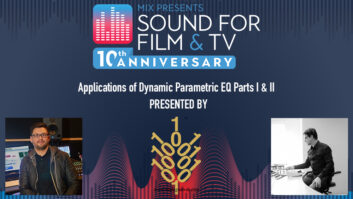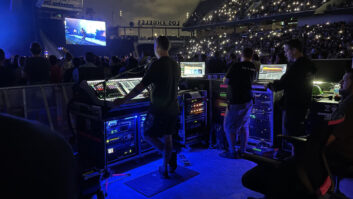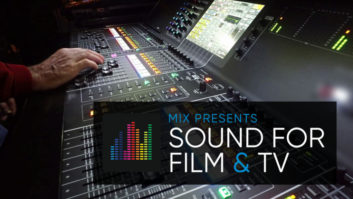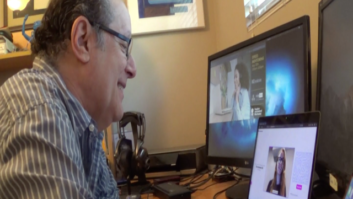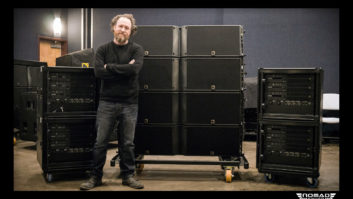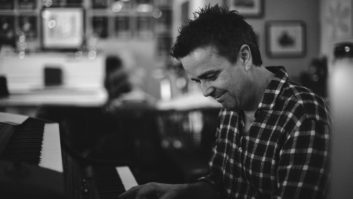The Chicago Cubs may not have made the World Series (just wait ”til next year!), but the Audio Engineering Society pulled off a miracle: AES NYC was packed with attendees, exhibitors and hot new products. Walking through the crowded aisles at the Javits Convention Center, the vibe was upbeat and alive. Many felt that this was the best AES show in a decade, and they were right.
Clearly, 2003 is not 1993, and today’s AES show is an entirely different beast, with a whole lotta talking on non-vintage topics such as networking, FireWire, multiplatform connectivity and the external functionality of consoles as controllers. Meanwhile, the dealings of computer companies such as Microsoft and AMD have become major events in our lives, while talk about OS X compatibility peppers regular conversations. Certainly, Guitar Center stepping up as an Apple reseller speaks volumes about a changing industry. However, we’re all audio hounds at heart, and if something makes, stores or tweaks sounds, we wanna know about it. Here are a few AES debuts that caught our attention.
GOING STRAIGHT TO DISK
Digidesign (www.digidesign.com) Pro Tools users who have hit the DSP headroom ceiling will rejoice at the release of the HD Accel card, which allows for higher voice counts and features nearly twice the raw DSP power of HD Process cards. (HD Core card doesn’t change.) Accel is included with Pro Tools|HD 2 Accel and HD|3 Accel systems, and may also be purchased separately ($4,995). Digi’s newest I/O box, dubbed the 96I ($2,195), operates at up to 24-bit/96kHz, with 16 analog inputs, two analog outs, S/PDIF I/O and more. Also shown was the Impact Mix Bus Compressor ($695), Digi’s first TDM plug-in compatible exclusively with HD Accel, offering support for up to 7.1 surround at up to 192 kHz.
Iin addition to the Dream Constellation console, Fairlight (www.fairlightau.com) hits were the StationPLUS integrated mixer and editor and the Pyxi Non Linear Video (NLV). StationPlus doubles the capacity of Station — taking the integrated mixer/editor from 56 channels and 24 buses to 144 channels and 48 buses — and provides control of Nuendo and Pro Tools record/edit platforms, and features the ability to add VCA-style fader groups. Pyxis NLV offers sync and transfer, touchscreen interface, network-ready project management, and support for 9-pin control.
The DR-100 digital recorder from Otari (www.otari.com) features 48-track recording at 24-bit, 44.1/48kHz, and 24-track recording at 24-bit, 88.2/96k direct to a 72GB SCSI drive. Up to 208 virtual tracks are available, with five editing layers totaling 256 tracks. The unit features MADI interfacing and a 48-track remote control.
Genex (www.genexaudio.com) demoed new accessories for the GX9000 Series, including the GXR948 Remote Controller. Also, GXP Edit is a plug-in waveform editor for Genex GXR PC control software that enables cut, copy, paste and erase operations on up to 48 channels of audio data. The GXRMB meter bridge provides 48 channels of metering. Also announced was file exchange capability with Merging Technologies.
Tascam‘s (www.tascam.com) SX-1LE Digital Production Workstation offers 16-track, 24-bit hard disk recording with full editing capability (including 5.1 surround), a 40-input 32×8 digital mixer, 16 mic pre’s, a CD-RW drive and a built-in MIDI sequencer — all for under $3,000.
Merging Technologies (www.merging.com) showed the new 16-channel DSD Pyramix system, also available in 2- or 8-channel options. Software enhancements include Scarlet Book specification authoring and the ability to monitor the 16-channel mixed signal path during DSD recording. Merging also showed the Vcube Video HD recorder/player and CEDAR Retouch.
MOTU (www.motu.com) unveiled the 896HD ($1,295), a two-rackspace FireWire audio interface for Mac and Windows PCs. The 896HD replaces the 896 at the same price and adds many new features, including 22 simultaneous outputs, 192kHz operation, 8-bus monitor mixing and stand-alone operation.
A few major application upgrades debuted. Cakewalk‘s (www.cakewalk.com) Sonar 3 includes a redesigned interface featuring a Dynamic Console view with per-channel, 6-band parametric EQ and assignable effects controls; a Universal Bus Architecture; gapless effects patching; VST/VSTi support; and many MIDI enhancements. Sonar 3 includes Lexicon’s Pantheon reverb, which has 35 factory presets, six reverb types and 16 editable parameters.
M-Audio (www.m-audio.com) and Ableton (www.ableton.com) announced Live 3, which, in addition to matching samples of any tempo and pitch, lets users dig into the samples themselves, modifying aspects like volume, pitch, pan and effects controls by drawing parameters as clip envelopes.
Two desktop workstations are ready for prime time: Lexicon‘s (www.lexiconpro.com) Omega is a 24-bit computer recording system that includes the Omega 8×4×2 USB I/O mixer, ProTracks Plus 32-track recording software and Pantheon. Omega includes two dbx mic pre’s, four TRS active balanced line ins and an S/PDIF combined with an additional DAC, plus MIDI I/O. Mackie‘s Spike (www.mackie.com) comprises an XD-2 2-channel USB, 24-bit/96kHz audio/MIDI interface with Mackie mic preamps and onboard SHARC dynamics processing, plus Tracktion multitrack audio production software with unlimited track count, VST plug-in support and the Nomad Factory Blue Tubes Warmer Phaser plug-in.
PLUG-INS!
Plug-ins made a strong showing. Waves (www.waves.com) introduced the granddaddy of all plug-in packages: the Diamond Bundle. With 35 apps from Waves’ Platinum, Transform and Restoration Bundles in one package, the Diamond Bundle has plenty of software tools. And at $7,000/TDM or $3,800/native, it’s a lot cheaper than buying them individually.
Eventide (www.eventide.com) showed two new TDM plug-ins, based on Orville technology: The Octovox Harmonizer allows eight voices of diatonic pitch shifting, in a “music notation meets step sequencer” interface. The Reverb plug-in has an integrated compressor, dual delay and pre/post 3-band parametric EQ.
Sony (www.sony.com) brings Oxford plug-ins to the masses with new Pro Tools LE versions of the EQ, Dynamic and Inflator, available individually or as a $700 bundle. A new Transient Modulator plug-in, which “revitalizes” track dynamic level by manipulating transient material, is available for LE and TDM.
TC Electronic (www.tcelectronic.com) has new PowerCore plug-ins: The VoiceModeler features Helicon voice processing technology, Intonator HS allows vocal intonation correction, Filtroid is a dual filter bank and Dynamic EQ offers four bands of processing.
BIAS (www.bias-inc.com) showed Peak 4 on the Apple G5. But the big news was Sound-Soap Pro, a beefed-up version of its Sound-Soap plug-in offering 512-band noise reduction via four restoration tools, including Hum & Rumble, Click & Crackle, Broadband and Noise Gate.
Native Instruments (www.native-instru ments.com) and Sonic Network (www.sonicnetworkinc.com) are bundling the Kontakt Player Silver sample player and Sonic Implants libraries to provide a sample-playback sound library for Sibelius 3. NI also offered the NI Komplete bundle, including Reaktor Session, Kontakt, Battery, Absynth 2, Vokator, Ni-Spektral Delay, FM7, B4 Organ and Pro-53 for $1,499.
SoundToys (www.soundtoys.com), formerly Wave Mechanics, showcased the UltraFX line of eight plug-ins, two of which debuted at AES. FilterFreak uses a 48dB/octave analog modeling filter, with programmable rhythmic filtering, triggered envelopes and tempo-controlled LFOs. PhaseMistress combines analog phasing with tempo-locked modulation and programmable LFOs.
SADiE (www.sadie.com) demoed CEDAR‘s (www.cedar-audio.com) Retouch Version 2, including an audio preview facility for auditioning the processed audio within the Retouch window without writing the process back to the playlist to determine the result. In addition, users can now load a full minute of audio.
In other plug-in news, Steinberg (www.steinberg.net) announced support of the DTS encoder for Nuendo. Trillium Lane Labs (www.tllabs.com) showed the TL EveryPhase phaser modeling plug-in for Pro Tools. Arturia (www.arturia.com) announced the CS-80V, a Yamaha CS-80 emulation. SFX Machine‘s (www.sfxma chine.com) namesake plug-in added MIDI parameter controls and is now available for Mac and Windows.
Harrison (www.glw.com) unveiled its new DTC plug-ins, which run on any IKIS-based Harrison console and feature a BeOS GUI. The DTC package consists of a dedicated processing module, with a standard array of 32 bus limiters with “Look Ahead,” “Anti Breathe” control and a suite of software plug-ins (sold separately) added to the digital.engine DSP core on an IKIS automation system.
Unique Recording (www.ursplugins.com) demoed new plug-ins modeled after two legacy designs. The URS 550B EQ features a Class-A digital algorithm plus four bands of EQ, each offering seven selected frequency centers. The URS 1084 EQ features a low band with four frequency centers, mid band with six frequency centers and high band with three selected frequency centers. Both plug-ins are ported for Pro Tools | HD and HD Accel on both OS X and OS 9. Pricing: TDM/RTAS, $899, non-TDM/RTAS, $449.
CONSOLES!
Present at the show and looking healthy, Fairlight unveiled the Dream Constellation console, boasting new automation functionality, up to 144 channels, 48 buses and 32 mono multitrack buses. Automation and audio can be edited simultaneously, enabling the user to move clips, tracks, ranges or entire projects with previously written automation. Able to accommodate up to four QDC cards and with updated Dream Series 3.1 software, the board features access to Creamware plug-ins, has an updated GUI and offers fader control of Nuendo and Pro Tools. Base price is $120K.
API (www.audiotoys.com) showed Vision, its high-end, multiformat Vision 5.1 surround mixing console that was profiled in last month’s Mix.
Solid State Logic (www.solid-state-logic.com) showed enhancements to its C200 digital console, which include SSL Quad bus compressor emulation and a USB interface option. In addition, find enhanced third-party router integration, two new meter views and added information on mic pre and pan format status.
Sonosax (www.sonosax.ch) launched the SX-ST/VT portable film production console based on its popular SX-S model. The new mini-desk handles as many as 32 inputs and features eight main buses, four aux buses, a monitor section with five LED meters and a communication system with two discrete lines. Prices start at $12,900.
Logitek Electronic Systems (www.logitek.com) introduced the Route-XY ($1,250), an I/O selector for the Logitek Audio Engine. The unit converts analog or sample rate converts digital signals, then routes and mixes the signals in the digital domain.
TOYS IN THE RACK
Put former Opcode, Be, Passport and E-mu/Creative minds together and what happens? You get the Receptor, the debut from newly formed Muse Research (www.museresearch.com). Receptor is a software-programmable hardware interface capable of running VST synths, effects, processors and instruments. Receptor can control over 16 channels of audio (via digital or balanced analog I/O) or synths with up to 57 effects. A built-in hard drive is loaded with plug-ins.
Manley (www.manleylabs.com) announced eight new products, including a 24/192 A/D and D/A converter; FLuRB, a surround matrix decoder that creates 5.1/6.1/7.1 playback from a FLRB coincident array; a dual-channel (one tube/one discrete solid-state) preamp; the Mini Massive Passive 2-band EQ; a utility mic/preamp switcher for auditioning various mic/pre combinations without tedious repatching; and a slew of devices designed for mastering applications.
Focusrite (www.focusrite.com) announced The Liquid Channel, which is said to offer the ability to emulate any classic mic preamp/compressor combination by applying unique level-dependent impulse responses to every audio sample. This is enhanced by its high-end, variable-impedance mic preamp circuitry and a new digital EQ based on Focusrite’s ISA110 sound.
Rane‘s (www.rane.com) new digital products include the PEQ-55 parametric; the DEQ-60L Perfect-Q cut-only, long-throw fader stereo graphic also has 3-band tone controls; and the G4, a full-function, look-ahead digital quad gate. Our fave? The MM 42 IEM processor, with 3-band compression, 5-band parametric, 3-band peak limiting and cue bus for multi-unit interconnection.
SSL‘s new Xlogic rackmount processors hail from its successful XL 9000 K console. The $3,595 XLogic Channel is a mic/line/instrument preamp with Twin-Curve dynamics, high/lowpass filters with routing to the dynamics sidechain, G and E series EQ and switchable metering; a digital interface card is optional. The 6-channel XLogic Multichannel Compressor ($6,995) has separate controls for the LFE channel and separate L/C/R and surround channel trims with different thresholds for each input. The unit can also be set up as separate four-channel and twin stereo compressors. The $4,345 XLogic SuperAnalogue Mic Amp combines four XL 9000 K preamps with optional remote control. The XLogic G Series Compressor ($3,355) features compression and sidechain bypass and the familiar SSL autofade switch.
MICROPHONES!
You can never have enough mics. The 1965 Sony C-38 (www.sony.com) was the world’s first FET mic, which after a few minor changes — windscreen shape (C-38A) and the ability to accept either 9VDC battery or phantom power (C-38B) — sold more than 65,000 units worldwide. Now, the famed dual-pattern (cardioid/omni) condenser C-38B is back as a faithful $2,200 reissue.
Telefunken North America‘s (www.telefunkenusa.com) Ela M 270 re-creates perhaps the rarest tube mic of all time: a stereo version of the Ela M 251. The handcrafted 270 is not for everyone, but listing at $19,995, it’s nice to dream. The company also announced its Ela M 14 (a cardioid-only tube mic with CK12 capsule), priced at $2,995; the Ela M 12, a C12 replica priced at $6,495; and the U47M, which reprises the classic Telefunken U47 in several versions with various tube options from $5,500 to $7,500. Another U47 clone came in the form of Wunder Audio‘s (www.wunderaudio.com) $4,000 CM7, with an EF14 tube and 6-micron diaphragm on a German M7 capsule.
Dirk Brauner (dist. by www.transaudio.com) showed VMA, an upscale (!) version of his $5,000 VM1A tube studio mic. Priced about 30% higher than the original, the new model has a switch that kicks in alternate circuitry for a choice of original or a more “vintage” sound. Thinking stereo? AEA‘s (www.wesdooley.com) R88 puts a matched pair of large, figure-8 ribbon capsules (angled at 90°) in a single housing for Blumlein or M-S stereo recording. Price: $1,895.
Neumann celebrated its 75th anniversary by unveiling a 300-page “coffee table” book with 500 color photos detailing its history. Neumann also showed the mid-priced, TLM 127 large-diaphragm, multipattern condenser mic with a remote pattern-switching option and impressive 7dBA self-noise.
PLM (dist. by www.independentaudio.com) unveiled the DT40 (five-pattern) and CT40 tube mics, based on Pearl’s classic, large-diaphragm, rectangular condenser capsule, paired with Nuvistor tubes. The Lawson AIR mic (www.lawsonmicrophones.com) is a hypercardioid condenser model specifically for vocal recording, with a new large-diaphragm capsule designed by Gene Lawson. New mics at SE Electronics (www.seemics.com) include ICIS (a $999 tube model with fixed cardioid pattern) and Gemini, a $1,499 cardioid with dual 12AU7s.
The DigiMic? Not exactly — BLUE Microphones (www.bluemic.com) teamed up with Digidesign to offer a special-edition mic, supplied exclusively with future Digi product bundles. Dubbed the Bluebird, the new mic is a large-diaphragm, cardioid condenser with low-noise Class-A electronics, Blueberry hi-def cable, shockmount and pop screen.
ACOUSTICAL MATERIALS
Developed by producer Keith Olsen and engineer Anthony Grimani, StudioPanel from MSR Inc. (www.msr-inc.com) is an “Engineered Acoustic Solution in a Box,” providing easy-to-configure systems with traps, absorbers, diffusors and complete instructions to optimizine project rooms. Primacoustic (www.primacoustic.com) expanded its studio solutions with the Polyfuser, a dual-function LF bass trap combined with wideband diffusion.
MONITORS
AES had tons of new monitors. Here are just a few: Linn (www.linn.co.uk) debuted its 318A four-way, powered near-fields, which feature 1,000 watts (total) of quad-amplification and a servo-controlled bass response system. Another quad-amped design, Blue Sky (www.abluesky.com) demoed its Big Blue, a 500-watt three-way with dual 8-inch woofers, 4-inch cone mid and 1-inch tweeter. EMES (www.xvisionaudio.com) unveiled a full line of conventional (non-Owl) active two-way near/mid-field monitors, for use with/without optional powered subs. Intelligent Audio Systems (www.intelligentaudiosystems.com) launched its RADS™ line of “intelligent, adaptive” active subs that adapt to the listening environment. Now available in a complete 5.1 surround package, PMC‘s (www.pmc-speakers.com) DB1 is a compact two-way monitor, unpowered for your choice of amplifiers; an active TLE1 sub is optional. Klein + Hummel returned to the U.S. pro market by establishing K+H North America (www.khna.com) and a full line of active, high-res monitors.
Tannoy (www.tannoy.com) took a giant step with Ellipse iDP™, a new, intelligent active monitoring system combining its Dual Concentric™ and Wideband™ technologies with DSP expertise from TC Electronic. Besides the unique ellipsoidal enclosures, the system offers full bass management, instant recall of preselected crossover frequencies and delay/room compensation EQ — all storable/recallable from presets or a remote.
MORE TO COME!
There were lots of other cool products at AES, and we’ll present these in our regular new-products columns in upcoming issues. Meanwhile, AES returns to Berlin from May 8 to 11, 2004, and the next U.S. AES swings into San Francisco from October 28-31, 2004.
Technology Spotlight
Mackie dXb Digital Console
Mackie (www.mackie.com) turned heads with the debut of its dXb digital console. The “X” operates with 72×72 of I/O at 96 kHz and lower, and is capable of 36×36 of I/O at 192 kHz. The desk features 24 channel strips with 100mm P+G moving faders, two integrated 15-inch touchscreens, and it will operate as a fully functional Mackie Control Universal offering control for Nuendo, Pro Tools, Cubase, Logic and more. It also comes fitted with one UAD-1 card, giving the user access to a long list of popular DSP processors. In addition, “X” boasts powerful automation and FireWire I/O option cards for streaming audio to and from a computer. I/O is truly flexible and can be configured any way the user wants. Other features include a tape-style transport with memory location recall, weighted jog/shuttle wheel, padded armrest with built-in mouse pad, and a control room section that allows for A/B monitoring, dual phones mixes and talkback. Pricing is targeted at under $20K.
Technology Spotlight
JBL LSR6300 Series Studio Monitors
Five years ago, JBL (www.www.jblpro.com) unveiled its award-winning LSR (Linear Spatial Reference) monitors. Now with its latest LSR6300 Series, JBL addresses the problem of room acoustics caused by the physical properties the space itself. The new THX™-approved Series has three models: The LSR6328P is a bi-amplified system with 8-inch woofer and 1-inch tweeter; the three-way LSR6332 has a 12-inch woofer, 5-inch mid and 1-inch tweeter; and the LSR6312SP is a powered sub with onboard bass management.
Designed to counteract the boomy LF standing waves created by a room’s geometry, the LSR6328P and the LSR6312SP feature JBL’s RMC™ (Room Mode Correction) circuits. An RMC Calibration Kit (included with the sub, and optional with the LSR6328P) provides everything needed to measure the room response, identify the dominant room mode and calibrate system response. The kit also includes a test tone disk and simple SPL meter to set the integral 22 bands of 1/10th-octave, analog parametric filters (between 26 and 96 Hz) that notch out offending frequencies. The LSR6328P also provides boundary compensation filters for use when the speaker is placed/mounted on a wall, corner or large furniture surface.
Hits You May Have Missed
Audix (www.audixusa.com) has updated its SCX-1 small-diaphragm condenser mics. The new SCX-1PR bodies have multiposition pad and bass rolloff switches for more versatility.
Blue Sky (www.abluesky.com) showed a slick system of monitor stands, with quick height setting and full angle adjustment for precise placement.
CableTek (www.cabletek.ca) intro’d three new Jensen transformer-based interfaces: a 6-channel rackmount DI, perfect for 5.1 applications; an isolation box, the missing link for trouble-free interconnection of sound systems; and the J-PC, a computer audio interface.
Crown‘s free Pocket IQ application allows control of TCP/IQ-based networks with a PDA running MS Pocket PC 2002 on the ARM processor, like the HP 3855 or 5450 iPaq.
Groove Tubes‘ (www.groovetubes.com) “The Brick” is a brick-sized, mono tube mic pre/direct box/line driver for studio/stage use. Retail: $499.
Littlelabs‘ (www.littlelabs.com) $600 Multi Z PIP works as an instrument preamp, re-amper, DI and mini instrument mixer.
Terrasonde‘s (www.terrasonde.com) $2,490 Digital Audio Toolbox offers some 20 digital domain tests in one unit. Also new? The $899 Studio Tool Box, with a bevy of useful studio functions, and the Analysts Firmware accessory, bringing sophisticated multiband RT60, STIpa intelligibility and time/delay waterfall measurements to any Audio Toolbox owner.
Whirlwind‘s (www.whirlwindusa.com) CobraNet-based digital E Snake can transport 32 channels each way over 100 meters of CAT-5 cable.
